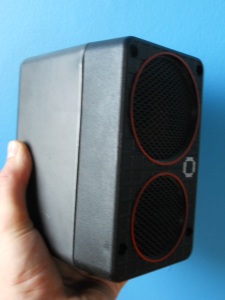(2013 – in progress)
Typical harmonic resonators are strings and acoustic pipes: when energy is introduced (e.g. by respectively plucking or hitting on an open end), they produce a (short) harmonic oscillation.
It is possible to understand such oscillators as a discrete (i.e. a chopped-up) representation: a string can be thought of as a concatenation of masses and springs.
Given that there exists a theory that links the mechanical, acoustical and electrical basic principles, it is possible to represent this mass-spring concatenation as a discrete electronic circuit, consisting of a series of capacitors and coils (in technical jargon this is also known as a “discrete transmission line”).
However, in reality, these components also contain losses (which are not considered in the theoretical concept), which is the principal reason why such a circuit has never been explored for musical purposes.

Nevertheless, a careful theoretical study revealed that suitable components can be found, where the losses are minimal, so that such a novice electronic oscillator could be constructed. Two eight-node prototypes have been built, confirming the theoretical findings and producing the first electronic-harmonic resonances.
The next steps will involve the implementation of manipulatable electronic components to enable pitch control, and the design of suitable electronic excitation circuits to enable the production of self-sustained sounds (just like wind instruments and bowed strings do).
A paper discussing the development and functional evaluation of the first prototype can be found here.








